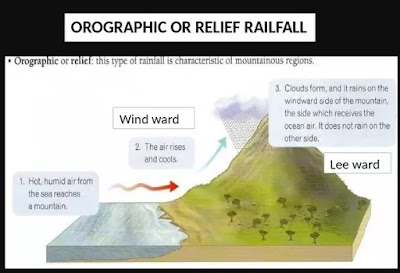What do you know about RAIN??????
Rain is a kind of precipitation.
Precipitation is any kind of water that falls from clouds in the sky, like
rain, hail, sleet and snow.
It is measured by a rain gauge. Rain is part of the water cycle.
Clouds will often absorb smoke to
create rain, commonly referred to as "nature's laundry" due to this
process, some places have frequent rain and some have little rain. This
makes deserts.
A rainstorm is a sudden heavy fall of rain. It may cause flash floods in
valleys. Heavy rain for a long time may make floods that
destroy houses and drown people. Also, landslides may
happen. There are three main types of rainfall.
1.
Convectional Rainfall
2.
Cyclonic/Frontal Rainfall
3.
Orographic/Relief Rainfall
Convectional
Rainfall
When the Sun heats the Earth's surface, the ground heats the air
above it. The air expands and forced to rise to great height. As the
air rises, it cools and becomes saturated and dew point temperature (the
temperature at which water vapour in the air condense (gas-liquid)) is attained
and then clouds will form. By further cooling, precipitation takes place. Turbulence
in the atmosphere and surface obstructions such as hills and mountains provide
the initial upward push for the air. This rainfall occurs throughout the year near
the equator daily in the afternoon. In middle latitudes, convectional rainfall
occurs in early summer, in continental interiors.
Orographic/Relief
Rainfall
It usually
occurs along coastal areas where a line of hills runs
along the coast.
When wet onshore wind from the sea meets a mountain, hill or
any other sort of landform barrier,
it is forced to rise along the slope and
cools. When the air temperature falls to its dew point, water vapour condenses
to form clouds. When the clouds can no longer hold the water droplets, relief
rain begins to fall on the windward slope of the
mountain. On the leeward side, air sinks, it is warmed and
further dried by compression. Therefore, the leeward slope is
known as the rain shadow region. Moist winds blow in from
the sea and are forced to rise over the land. The air cools and the water
vapour condenses, forming raindrops.
Frontal/Cyclonic
Rainfall
This
type of precipitation associated with a cyclonic activity and occurs along the
frontal zone (front is a narrow zone of transition, dividing two air masses of
differing temperature and humidity characteristics, intersecting the earth's
surface). It happens when cooler air and warmer, humid air meet in
a weather front. The less-dense warm air rises
and condenses forming clouds. These clouds grow and eventually create rain. In
some places on the northern temperate
zone the cold air front tends to come from the north-west and
the warm air front comes from the south-west.












Leave a Comment